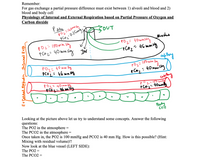
Human Anatomy & Physiology (11th Edition)
11th Edition
ISBN: 9780134580999
Author: Elaine N. Marieb, Katja N. Hoehn
Publisher: PEARSON
expand_more
expand_more
format_list_bulleted
Question
thumb_up100%
I struggled my homework with this questions. Can you help me, please?

Transcribed Image Text:**Educational Content: Physiology of Internal and External Respiration**
**Understanding Gas Exchange:**
Gas exchange in the human body relies on a crucial principle: a partial pressure difference must exist between:
1. The alveoli and blood.
2. The blood and body cells.
**Diagram Explanation:**
The diagram illustrates the partial pressures of oxygen (PO₂) and carbon dioxide (PCO₂) at various stages of respiration.
1. **Atmospheric Air:**
- PO₂ = 160 mmHg
- PCO₂ = 0.25 mmHg
2. **Alveoli:**
- PO₂ = 100 mmHg
- PCO₂ = 40 mmHg
- Notes the direction of flow: Air moves IN and OUT of the alveoli.
3. **Capillary Blood (Entering Lungs):**
- PO₂ = 40 mmHg
- PCO₂ = 46 mmHg
4. **Capillary Blood (Leaving Lungs):**
- PO₂ = 100 mmHg
- PCO₂ = 40 mmHg
5. **Body Cells:**
- PO₂ = 40 mmHg
- PCO₂ = 46 mmHg
**Concept Questions:**
- **Partial Pressures in the Atmosphere:**
- PO₂ = ?
- PCO₂ = ?
- **Respiratory Exchange:**
- Once inhaled, why does the PO₂ decrease to 100 mmHg, and PCO₂ increase to 40 mmHg? Consider the mixing of fresh air with residual volume in the lungs!
- **Capillary Exchange (LEFT SIDE):**
- PO₂ = ?
- PCO₂ = ?
Understanding these differences in partial pressures is essential for comprehending how oxygen enters the blood and carbon dioxide is expelled, facilitating efficient respiration and cellular function.
Expert Solution
This question has been solved!
Explore an expertly crafted, step-by-step solution for a thorough understanding of key concepts.
Step by stepSolved in 3 steps with 1 images

Knowledge Booster
Similar questions
arrow_back_ios
arrow_forward_ios
Recommended textbooks for you
 Human Anatomy & Physiology (11th Edition)Anatomy and PhysiologyISBN:9780134580999Author:Elaine N. Marieb, Katja N. HoehnPublisher:PEARSON
Human Anatomy & Physiology (11th Edition)Anatomy and PhysiologyISBN:9780134580999Author:Elaine N. Marieb, Katja N. HoehnPublisher:PEARSON Anatomy & PhysiologyAnatomy and PhysiologyISBN:9781259398629Author:McKinley, Michael P., O'loughlin, Valerie Dean, Bidle, Theresa StouterPublisher:Mcgraw Hill Education,
Anatomy & PhysiologyAnatomy and PhysiologyISBN:9781259398629Author:McKinley, Michael P., O'loughlin, Valerie Dean, Bidle, Theresa StouterPublisher:Mcgraw Hill Education, Human AnatomyAnatomy and PhysiologyISBN:9780135168059Author:Marieb, Elaine Nicpon, Brady, Patricia, Mallatt, JonPublisher:Pearson Education, Inc.,
Human AnatomyAnatomy and PhysiologyISBN:9780135168059Author:Marieb, Elaine Nicpon, Brady, Patricia, Mallatt, JonPublisher:Pearson Education, Inc., Anatomy & Physiology: An Integrative ApproachAnatomy and PhysiologyISBN:9780078024283Author:Michael McKinley Dr., Valerie O'Loughlin, Theresa BidlePublisher:McGraw-Hill Education
Anatomy & Physiology: An Integrative ApproachAnatomy and PhysiologyISBN:9780078024283Author:Michael McKinley Dr., Valerie O'Loughlin, Theresa BidlePublisher:McGraw-Hill Education Human Anatomy & Physiology (Marieb, Human Anatomy...Anatomy and PhysiologyISBN:9780321927040Author:Elaine N. Marieb, Katja HoehnPublisher:PEARSON
Human Anatomy & Physiology (Marieb, Human Anatomy...Anatomy and PhysiologyISBN:9780321927040Author:Elaine N. Marieb, Katja HoehnPublisher:PEARSON

Human Anatomy & Physiology (11th Edition)
Anatomy and Physiology
ISBN:9780134580999
Author:Elaine N. Marieb, Katja N. Hoehn
Publisher:PEARSON

Anatomy & Physiology
Anatomy and Physiology
ISBN:9781259398629
Author:McKinley, Michael P., O'loughlin, Valerie Dean, Bidle, Theresa Stouter
Publisher:Mcgraw Hill Education,

Human Anatomy
Anatomy and Physiology
ISBN:9780135168059
Author:Marieb, Elaine Nicpon, Brady, Patricia, Mallatt, Jon
Publisher:Pearson Education, Inc.,

Anatomy & Physiology: An Integrative Approach
Anatomy and Physiology
ISBN:9780078024283
Author:Michael McKinley Dr., Valerie O'Loughlin, Theresa Bidle
Publisher:McGraw-Hill Education

Human Anatomy & Physiology (Marieb, Human Anatomy...
Anatomy and Physiology
ISBN:9780321927040
Author:Elaine N. Marieb, Katja Hoehn
Publisher:PEARSON